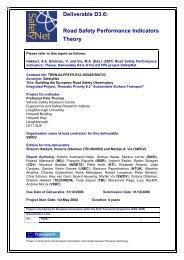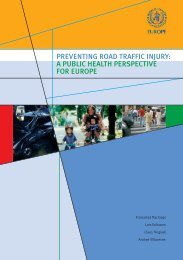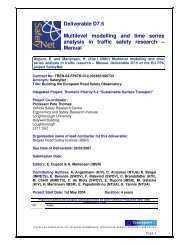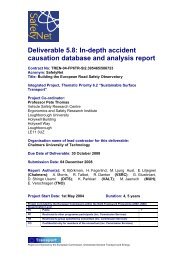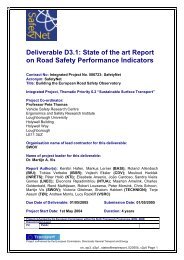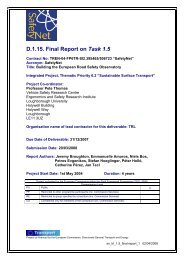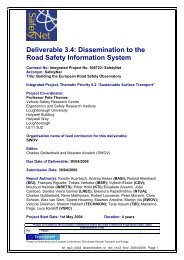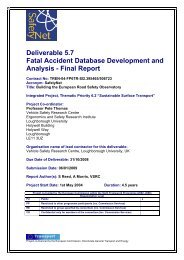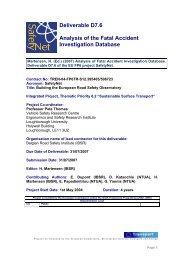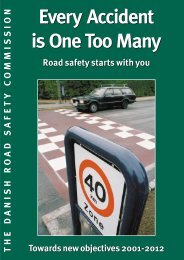Glossary of Data Variables for Fatal and accident causation ... - ERSO
Glossary of Data Variables for Fatal and accident causation ... - ERSO
Glossary of Data Variables for Fatal and accident causation ... - ERSO
Create successful ePaper yourself
Turn your PDF publications into a flip-book with our unique Google optimized e-Paper software.
Manual For SafetyNet <strong>accident</strong> <strong>causation</strong> system (SNACS)<br />
an intersection. In Kalle’s <strong>accident</strong> however, as he has already seen the<br />
intersection <strong>and</strong> “knows” that it is green, he also knows that he has the right <strong>of</strong><br />
way <strong>and</strong> that there is no reason not to drive into the intersection. Timing<br />
there<strong>for</strong>e is a better explanation <strong>of</strong> the physics <strong>of</strong> the situation.<br />
Next, we look at Appendix B <strong>and</strong> locate “Timing: No action” among the<br />
phenotypes, to see which the possible genotypes that are linked to this<br />
phenotype are. The table looks like this:<br />
PHENOTYPES (A)<br />
ANTECEDENTS<br />
(REASONS/CAUSES)<br />
GENERAL Genotypes<br />
Observation missed (B1)<br />
Faulty diagnosis (C1)<br />
Decision error (C3)<br />
Inadequate plan (D1)<br />
Inattention (E6)<br />
Communication failure -<br />
between drivers (J1)<br />
Communication failure -<br />
between driver <strong>and</strong><br />
environment (J2)<br />
GENERAL<br />
Phenotypes<br />
(Critical events)<br />
with definitions<br />
Timing (A1)<br />
The regulation <strong>of</strong><br />
time <strong>for</strong> actions to<br />
occur.<br />
CONSEQUENTS (RESULTS/EFFECTS)<br />
SPECIFIC<br />
Phenotypes (with<br />
definitions)<br />
Premature action<br />
(A1.1)<br />
An action started<br />
too early, be<strong>for</strong>e a<br />
signal was given or<br />
the required<br />
conditions had<br />
been established.<br />
Late action (A1.2)<br />
An action started<br />
too late.<br />
No action (A1.3)<br />
An action that was<br />
not done at all<br />
(within the time<br />
interval allowed).<br />
Examples <strong>for</strong><br />
SPECIFIC<br />
Phenotypes<br />
Per<strong>for</strong>ming an<br />
overtake be<strong>for</strong>e there<br />
is good visibility.<br />
Starting/stopping too<br />
early at traffic lights.<br />
Dip the lights too early<br />
when driving in the<br />
dark.<br />
Not changing lanes in<br />
time.<br />
Starting an overtake<br />
too late.<br />
Dip the lights too late<br />
when driving in the<br />
dark.<br />
Figure 9: Extract <strong>of</strong> the phenotype row Timing (A1) from the PHENOTYPES table<br />
in appendix B<br />
To the right in the table is the resulting phenotype (the consequent), <strong>and</strong> to the<br />
left are the possible genotypes (causes/reasons) that can generate the<br />
phenotype. In other words; if we can establish that any <strong>of</strong> the genotypes on the<br />
left has taken place, then it is legitimate to infer from this in<strong>for</strong>mation that the<br />
phenotype Timing (A1) can take place. In the case with Kalle, we know from the<br />
interview that he never saw the traffic light turn red. From this in<strong>for</strong>mation, we<br />
feel confident saying that the genotype “Observation missed (B1)” has<br />
contributed to the phenotype “Timing: No action” (A1.3). This gives us the start<br />
<strong>for</strong> a chain <strong>of</strong> analysis, looking like this:<br />
Page 136 <strong>of</strong> 215



